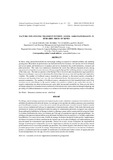| dc.description.abstract | In Africa, many pastoral households are increasingly settling in response to curtailed mobility and shrinking grazing areas. Households in pastoral areas are characterised by few resources, low income, low level of human and social capital, and limited access to markets and service institutions like credit institutions, extension and plant protection. This study was conducted to determine the factors that influence transient poverty among agro-pastoral communities in semi-arid areas of Kenya using the Njemps Flats in Baringo district as a representation of the study area. The land-use practice in the Njemps Flats is livestock and crop production (agro-pastolism). Regression techniques were used to determine the relationship between poverty and hypothesized explanatory variables. The number of livelihood sources, household size, distance to the nearest market, ownership of enclosures and household herd size were the most influential factors that determined poverty among agropastoral communities. The number of livelihood sources, education level of the household head, relief food, extension service and distance to the nearest markets were positively related to per capita daily income. A negative relationship was observed between per capita daily income and household size. Since poverty shows declining with positive influential factors, reduction of transient poverty can be achieved through enhancing and providing of livelihood alternatives to reduce over-reliance on livestock and land as primary sources of livelihood. | en_US |

